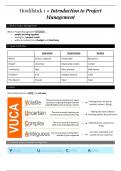Resume
Introduction to Project Management - Samenvatting
- Établissement
- Arteveldehogeschool (Artevelde)
Samenvatting van het eerstejaarsvak Introduction to Project Management uit de opleiding Event- en Projectmanagement aan de Arteveldehogeschool. Aangevuld met eigen notities uit de lessen van docent D. De Bruyne. Geslaagd in eerste zit met 16/20! Samenvatting in het Engels aangezien het vak oo...
[Montrer plus]



